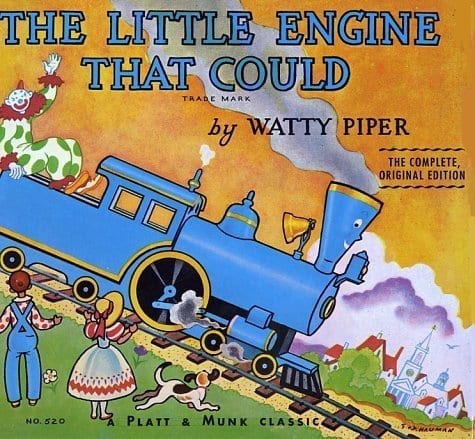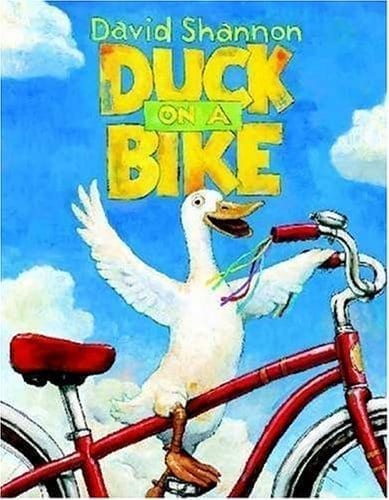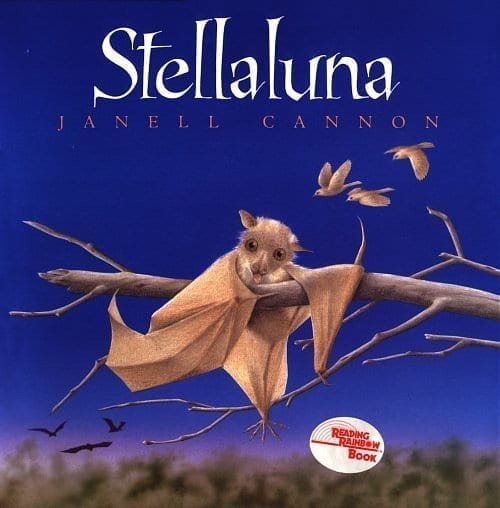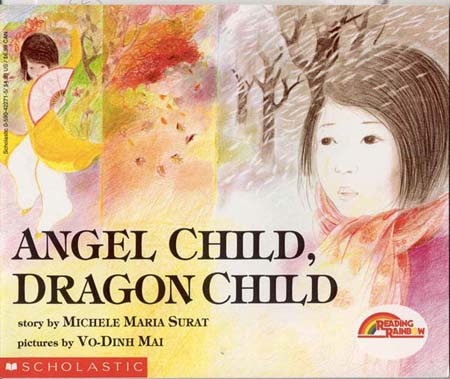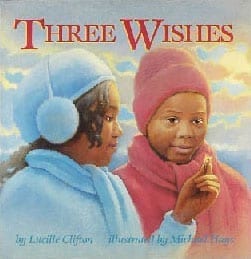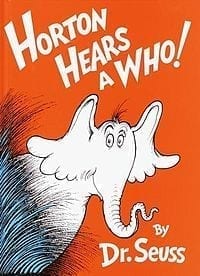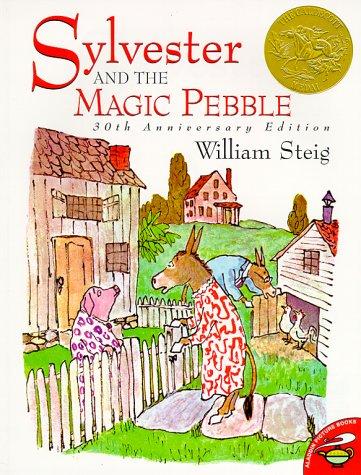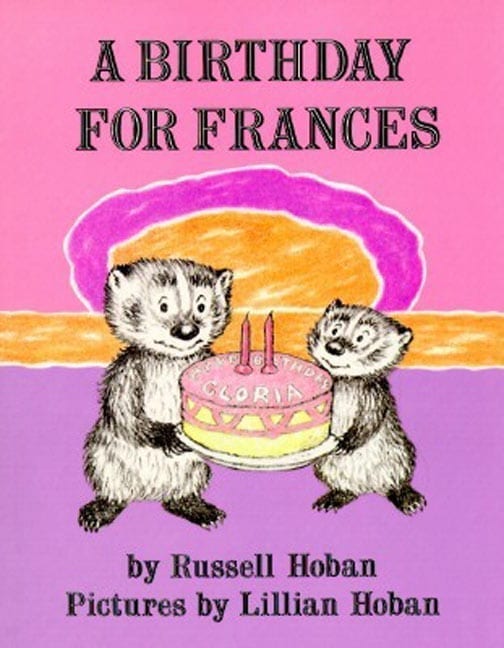“The Little Engine that Could” By Watty Piper
Although he is not very big, the Little Blue Engine agrees to try to pull a stranded train full of toys over the mountain. His use of positive self-talk, “I think I can, I think I can,” is what eventually makes his successful.
“Duck on a Bike” By David Shannon
A curious duck eyes a shiny red bicycle on the farm. Judging himself a worthy rider, Duck hops onto the bike and visits all the other animals on the farm. Each animal responds with what they think about Duck’s exploits. But when a large bike-riding group of youngsters arrive on the farm and head inside the house, their own bicycles become too much of a lure for the barnyard fellows and soon the yard is full of wheeling critters. Duck is a great example of taking a passion and sharing it with others or turning it outward.
“Stellaluna” By Janell Cannon
Baby bat Stellaluna’s life is flitting along happily, until an owl attacks her mother one night, knocking the bewildered batlet out of her mother’s loving grasp. The tiny bat is lucky enough to land in a nest of baby birds. Stellaluna’s adoptive bird mom accepts her into her nest, but only on the condition that Stellaluna will act like a bird, not a bat. Soon Stellaluna learns to behave like a good bird should. She quits hanging by her feet and starts eating bugs. But when she finally has an opportunity to show her bird siblings what life as a bat is like, all of them are confounded. This is a great story to show how to overcome challenges and maintain our individuality. Stellaluna uses character of heart to channel her energy in a positive way and along the way she makes new friends and learns about herself.
“Angel Child, Dragon Child” By Michelle Maria Surat
“Angel Child, Dragon Child” is a wonderful story about a Vietnamese child trying to adjust to life in the USA. Ut has trouble with children at school because she is different. Ut has difficulty speaking English and her clothes are different from what American children wear. After fighting with a boy, she is forced to sit in a room and talk to the boy. Can they work things out? Ut has a challenge learning how to fit in to her new community and has a choice to respond in a way that is destructive or one that is difficult but awards opportunity and self-respect. Surat does a terrific job of showing how Ut sees herself as a dragon child when she is feeling or thinking mean thoughts and as an angel child when she is being kind to others. In the end, Ut learns a lesson in plugging in when the whole school pulls together to try to raise money to bring her mom over. This is a wonderful story of accepting differences in others and the need to work together to survive in life.
“Three Wishes” By Lucille Clifton
Clifton’s newly illustrated story of a young African-American girl who realizes the importance of choices and the value of friendship is as fresh and vital today as it was when first published in 1976. On a New Year’s Day walk with her friend Victor, Nobie finds a penny with her birth year on it, a sure sign that she’ll have three wishes granted. After her first wish brings out the sun on the cold, gloomy day, she and Victor have a disagreement and her next angry wish that he leave is fulfilled. The wise words of her mother (her support system) help Nobie think about all the wonderful things that she and the boy have shared. Her last wish for a good friend brings a smiling Victor’s return. This story is also good for discussions on defense mechanisms.
“Horton Hears a Who” By Dr. Seuss
This book works with so many analogies that it is hard to narrow it down to one. This is a classic story of self-sacrifice, doing what’s right even if it’s hard, and the value of each person. This book instills self-respect in children by fostering caring and concern for others. On top of that, it’s just plain fun to read. “Because after all, a person is a person, no matter how small.” But mostly this is a book about Horton and his character of heart. Horton the Elephant represents kindness, trustworthiness, and perseverance, all wrapped up, thank goodness, in a comical and even absurd package. Horton hears a cry for help from a speck of dust, and spends much of the book trying to protect the infinitesimal creatures who live on it. But he faces many challenges because of the torments and taunts by the other animals. Horton wins in the end, after persuading the “Whos” to unite and make as much noise as possible and prove their existence.
“Sylvester and the Magic Pebble” By William Steig
On a rainy day, Sylvester finds a magic pebble that can make wishes come true. But when a lion frightens him on his way home, Sylvester makes a wish (choice) that brings unexpected results. Sylvester is turned into a large rock unable to do anything to help himself. Essentially he has lost all opportunity, freedom, and self-respect. Sylvester is eventually saved by his parents (his support system). How Sylvester is eventually reunited with his loving family and restored to his true self makes for a story that is beautifully tender and filled with magic.
“A Birthday for Frances” (or any of the “Frances” books) By Lillian Hoban
“A rainbow and a happy tree are not for Alice or for me. I will draw three-legged cats and caterpillars with ugly hats.” Frances deals with birthday envy and how to be generous when her little sister’s birthday rolls around. Frances does not say it out loud, but rather through her actions and her little rhymes we realize that she is unhappy that her sister seems to have all the birthdays and she doesn’t have as many. It also captures with such truth the complicated feelings siblings have for one another, such as the moment where Frances announces that she is not getting her sister Gloria a birthday present and then dissolves into tears because she is the only one not getting Gloria a present. As always, Mother and Father Badger are gentle and wise in their handling of their imaginative and precocious offspring. All the “Frances” books essentially deal with challenges and choices in responding to the challenges that are familiar to young children. Frances is the queen of “self-talk,” and she has a wonderful support system in her parents who are patient and kind with their advice.
“Once a Mouse…” By Marcia Brown
This Caldecott Medal Winner on opportunity, freedom, and self-respect tells a simple fable from ancient India that follows a man, a mouse, and the downfall of pride. A wise hermit lives alone in the forest when he happens to spy a mouse about to be eaten. Fearful for the little creature, the man changes his new friend into a cat. When a dog threatens his cat, he turns the mouse into a dog, and then (after a similar situation) into a tiger. Now a fine feline of a beast, the former mouse lords his newfound state over the other animals of the forest. After planning the death of his benefactor, the man changes the tiger into a mouse again and everything returns to its former state (with the mouse, I suspect, a little wiser). The reader is left, like the hermit, to meditate about how humans, like tigers, can get too big for their britches.
